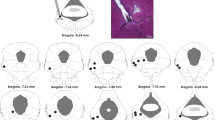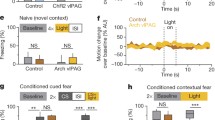Summary
In a previous study we investigated the intraspecific defensive reactions evoked by excitation of neurons in the intermediate third of the midbrain periaqueductal gray matter (PAG) of the rat. Experiments revealed that activation of neurons in this region of the PAG mediated: (i) backward defensive behavior, characterized by upright postures and backward movements, and (ii) reactive immobility (“freezing”), in which the rat remained immobile, but reacted with backward defensive behavior to investigative, non-aggressive contact initiated by the partner. In the present study, we aimed to extend our understanding of PAG mediation of defensive behavior by observing: (i) in a non-aggressive social interaction test, the behavioral effects of microinjections of low doses of kainic acid (40 pmol in 200 nl) made in the caudal third of the PAG; and (ii) the behavioral and cardiovascular effects of microinjections of d, l-homocysteic acid (5–10 nmol in 50–100 nl) made in the PAG of the unanesthetized decerebrate rat. Kainic acid injections into the area lateral to the midbrain aqueduct in the caudal third of the PAG evoked: (i) forward avoidance behavior, characterized by forward locomotion and occasional hop/jumps; (ii) reactive immobility (“freezing”), in which the rat remained immobile, but reacted with forward avoidance behavior to investigative, non-aggressive contact initiated by the partner; and (iii) 22–28 kHz ultrasonic vocalizations. These injections also evoked a dramatic increase in defensive responsiveness to tactile stimuli on the half of the body contralateral, but not ipsilateral, to the site of injection. Electroencephalographic measurements indicated that none of these effects were secondary to seizure activity. In the decerebrate rat, d, l-homocysteic acid injections in the caudal third of the PAG evoked forward running movements along with increased blood pressure and heart rate, the strongest effects being evoked from the region lateral to the midbrain aqueduct. More rostrally, sites in the intermediate PAG evoked backward “defensive” movements, which were also associated with increased blood pressure and heart rate. These data, along with those from our previous study in the rat indicate that: (i) defensive reactions are integrated within a longitudinal neuronal column which spans the caudal two thirds of the lateral PAG; (ii) the lateral PAG “defensive behavior” column contains two distinct populations of neurons, one within the intermediate lateral PAG which integrates defensive behavior characterized by facing towards and backing away from a “threatening” stimulus, and a second in the caudal lateral PAG which integrates defensive behavior characterized by forward avoidance behavior; and (iii) neurons within the lateral PAG couple strong cardiovascular changes with each distinctive defensive behavior pattern. The emerging view from this and recent studies of this midbrain region in other species, suggests that similar rostrocaudal differences within a longitudinally oriented lateral PAG neuronal column represent a fundamental principle underlying the PAG organization of defensive behavior.
Similar content being viewed by others
References
Bandler R (1988) Brain mechanisms of aggression as revealed by electrical and chemical stimulation: Suggestion of a central role for the midbrain periaqueductal grey region. In: Epstein A, Morrison A (eds) Progress in psychobiology and physiological psychology, vol. 13. Academic Press, New York, pp 67–154
Bandler R, Carrive P (1988) Integrated defence reaction elicited by excitatory amino acid injection in the midbrain periaqueductal grey region of the unrestrained cat. Brain Res 439: 95–106
Bandler R, Depaulis A (1988) Elicitation of intraspecific defence reactions in the rat from midbrain periaqueductal grey by microinjection of kainic acid, without neurotoxic effects. Neurosci Lett 88: 291–296
Bandler R, Carrive P, Zhang SP (1991a) Integration of somatic and autonomic reactions within the midbrain periaqueductal grey: viscerotopic, somatotopic and functional organization. Prog Brain Res 87: 269–305
Bandler R, Carrive P, Depaulis A (1991b) Emerging principles of organization of the midbrain periaqueductal gray matter. In: Depaulis A, Bandler R (eds) The midbrain periaqueductal gray matter: functional, anatomical and neurochemical organization. Plenum, New York, pp 1–8
Bandler R, Depaulis A, Vergnes M (1985) Identification of mid-brain neurons mediating defensive behaviour in the rat by microinjections of excitatory amino acids. Behav Brain Res 15: 107–119
Blanchard RJ, Blanchard DC (1981) The organization and modelling of animal aggression. In: Brain PF, Benton D (eds) The biology of aggression. Sijthoff and Noordhoff, Alphen aan den rijn, pp 529–562
Blomqvist A, Wiberg M (1985) Some aspects of the anatomy of somatosensory projections to the cat midbrain. In: Rowe MJ, Willis WD (eds) Development, organization, and processing in somatosensory pathways, Alan R Liss, New York, pp 215–222
Blomqvist A, Craig AD (1991) Organization of spinal and trigeminal input to the PAG. In: Depaulis A, Bandler R (eds) The midbrain periaqueductal gray matter: functional, anatomical, and neurochemical organization. Plenum, New York, pp 345–364
Carrive P (1991) Functional organization of PAG neurons controlling regional vascular beds. In: Depaulis A, Bandler R (eds) The midbrain periaqueductal gray matter: functional, anatomical and neurochemical organization. Plenum, New York, pp 67–100
Carrive P, Bandler R (1991) Redistribution of blood flow in extracranial and hindlimb vascular beds evoked by excitation of neurons in the midbrain periaqueductal grey of the decerebrate cat. Exp Brain Res 84: 599–606
Carrive P, Bandler R, Dampney RAL (1989) Somatic and autonomic integration in the midbrain: a distinctive pattern evoked by excitation of neurones in the subtentorial portion of the midbrain periaqueductal grey region. Brain Res 483: 251–258
Carrive P, Dampney RAL, Bandler R (1987) Excitation of neurones in a restricted region of the midbrain periaqueductal grey elicits both behavioural and cardiovascular components of the defence reaction in the unanaesthetised decerebrate cat. Neurosci Lett 81: 273–278
Depaulis A (1983) A microcomputer method for behavioural data acquisition and subsequent analysis. Pharmacol Biochem Behav 19: 729–732
Depaulis A, Vergnes M (1986) Elicitation of intraspecific defensive behaviors in the rat by microinjection of picrotoxin, a GABA antagonist, into the midbrain periaqueductal gray matter. Brain Res 367: 87–95
Depaulis A, Bandler R, Vergnes M (1989) Characterization of pretentorial periaqueductal gray neurons mediating intraspecific defensive behaviors in the rat by microinjections of kainic acid. Brain Res 486: 121–132
Di Scala G, Schmitt P, Karli P (1984) Flight induced by infusion of bicuculline methiodide into periventricular structures. Brain Res 309: 199–208
Fanselow M (1991) The midbrain periaqueductal gray as a coordinator of action in response to fear and anxiety. In: Depaulis A, Bandler R (eds) The midbrain periaqueductal gray matter: functional, anatomical and neurochemical organization. Plenum, New York, pp 151–174
Grant EC, Mackintosh JH (1963) A comparison of the social postures of some common laboratory rodents. Behaviour 21: 246–259
Hilton SM, Redfern WS (1986) A search for brainstem cell groups integrating the defence reaction in the rat. J Physiol 378: 213–228
Jones RO, Kirkman E, Little RA (1990) The involvement of the midbrain periaqueductal grey in the cardiovascular response to injury in the conscious and anesthetized rat. Exp Physiol 75: 483–495
Keay KA, Dean P, Redgrave P (1990) N-methyl D-aspartate (NMDA) evoked changes in blood pressure and heart rate from the rat superior colliculus. Exp Brain Res 80: 148–156
Keay KA, Bandler R (1992) Anatomical evidence for segregated input from the upper cervical spinal cord to functionally distinct regions of the periaqueductal gray region of the cat. Neurosci Lett 139
Krieger JE, Graeff FG (1985) Defensive behavior and hypertension induced by glutamate in the midbrain central gray of the rat. Brazil J Med Biol Res 18: 61–67
Menétrey D, Chaouch A, Binder A, Besson JM (1982) Neurons at the origin of the spinomesencephalic tract in the rat: An anatomical study using the retrograde transport of horseradish peroxidase. J Comp Neurol 206: 193–207
Mitchell I, Dean P, Redgrave P (1988) The projection from superior colliculus to cuneiform area in the rat. II. Defence-like responses to stimulation with glutamate in cuneiform nucleus and surrounding structures. Exp Brain Res 72: 626–639
Olivier B (1981) Selective anti-aggressive properties of DU 27725: ethological analyses of intermale and territorial aggression in the male rat. Pharmacol Biochem Behav 14 (Suppl 1): 61–77
Paxinos G, Watson C (1982) The rat brain in stereotaxic coordinates. Academic Press, Sydney
Redgrave P, Dean P (1991) Does the PAG learn about emergencies from the superior colliculus? In: Depaulis A, Bandler R (eds) The midbrain periaqueductal gray matter: functional, anatomical and neurochemical organization. Plenum, New York, pp 199–210
Schmitt P, Di Scala G, Jenck F, Sandner G (1984) Periventricular structures, elaboration of aversive effects and processing of sensory information. In: Bandler R (eds) Modulation of sensorimotor activity during alterations in behavioural states. Alan R Liss, New York, pp 393–414
Thomas DA, Takahashi LK, Barfield RJ (1983) Analysis of ultrasonic vocalizations emitted by intruders during aggressive encounters among rats (Rattus norvegicus). J Comp Psychol 97: 201–206
Shipley MT, Ennis M, Rizvi TA, Behbehani MM (1991) Topographical specificity of forebrain inputs to the midbrain peria-queductal gray: evidence for discrete longitudinally organized input columns. In: Depaulis A, Bandler R (eds) The midbrain periaqueductal gray matter: functional anatomical and neurochemical organization. Plenum, New York, pp 417–448
Verbene AJM, Struyker Boudier HAJ (1991) Midbrain central grey: regional haemodynamic control and excitatory amino acidergic mechanisms. Brain Res 550: 86–94
Yezierski RP (1988) Spinomesencephalic tract: projections from the lombosacral spinal cord of the rat, cat and monkey. J Comp Neurol 267: 131–146
Yezierski RP (1991) Somatosensory input to the periaqueductal gray: a spinal relay to a descending control center. In: Depaulis A, Bandler R (eds) The midbrain periaqueductal gray matter: functional, anatomical and neurochemical organization. Plenum, New York, pp 365–386
Yezierski RP, Broton JG (1991) Functional properties of spinomesencephalic tract (SMT) cells in the upper cervical spinal cord of the cat. Pain 45: 187–196
Zhang SP, Bandler R, Carrive P (1990) Flight and immobility evoked by excitatory amino acid microinjection within distinct parts of the subtentorial midbrain periaqueductal grey of the cat. Brain Res 520: 73–82
Author information
Authors and Affiliations
Rights and permissions
About this article
Cite this article
Depaulis, A., Keay, K.A. & Bandler, R. Longitudinal neuronal organization of defensive reactions in the midbrain periaqueductal gray region of the rat. Exp Brain Res 90, 307–318 (1992). https://doi.org/10.1007/BF00227243
Received:
Accepted:
Issue Date:
DOI: https://doi.org/10.1007/BF00227243




